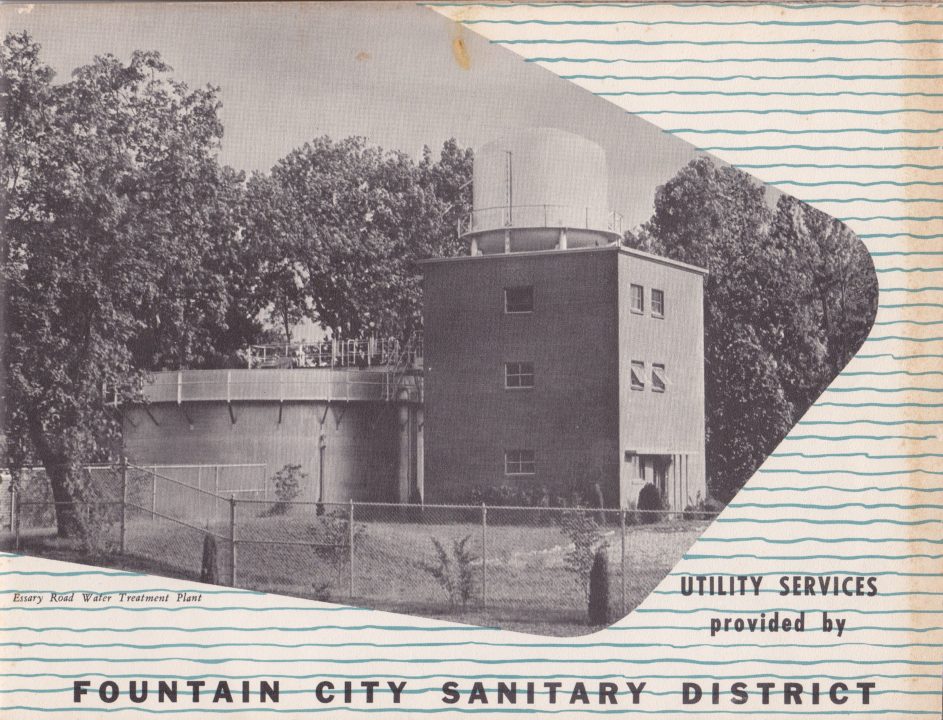Fountain City has been called Knoxville’s most fiercely independent community. In the 1940s, 1950s and 1960s a welcome sign on Broadway near Greenway proclaimed the message “The Nation’s Largest Unincorporated City.” Fountain City had its own Fountain City Water Co., Fountain City Sanitary District, Fountain City Fire Department and Fountain City Recreation Commission. Officer Curtis C. Brock acted as its chief law enforcement officer on loan from the Sheriff’s Office.
In the fall of 1931 when the Fountain City Water Co. became operational there were only 200 subscribers. In 1966, after about four years of negotiating with the city of Knoxville after annexation, there were 6,796.
A survey in 1928 found there were 1,400 residences in Fountain City. Each had its own cistern, well or spring. Contamination had resulted in some cases of typhoid fever, and the first efforts to obtain a public water supply were made.
The city of Knoxville refused to provide a connection and attempts were made to induce outside capital to construct and operate a system. Ultimately a St. Louis utility proposed a system, obtained a franchise and conducted preliminary engineering studies. After much delay, it decided the project was not financially feasible.
As the problem became more acute, a group of local citizens organized a private water utility in 1931. $25,000 in stock and a bond issue of $6,000 enabled them to begin operations with the aforementioned 200 subscribers by the fall of that year. Over the next 20 years, they increased the capital bond issues from time to time. By 1951 there were 3,786 subscribers and the original $31,000 investment had grown to $450,000.
As the population grew the use of a septic system at each residence had become a problem and, in 1945, the state legislature authorized the Fountain City Sanitary District (FCSD) to issue revenue bonds to finance a sewerage system. But, without control of the water supply, they were unable to impose sewer service charges.
In 1949 the Act was amended to permit the FCSD to construct or acquire a water system. The officials began negotiations to purchase the water system from its private owners. An engineering firm appraised the system, and eventually it was purchased at a price below the estimate. In January 1951, the FCSD took over the operation of the system.

A July 1957 report to its subscribers noted that the rapid growth of the suburb had resulted in over 2,000 new subscribers. The report said that at that time from one to two million gallons of water a day were required to meet subscriber demand. The treatment plant was supplying about one million gallons from local wells and springs. At first, the majority came from the Hall Spring and the Lake Spring. Later, the major spring at Cedar Lane and Fountain Ave. was added. When its flow became inadequate, a well was dug near that location and all four sources entered the collection box located there.
Increased demand required a fund-raising in the community and successful negotiation with the Knoxville Utilities Board resulted. A 16-inch main was installed connecting the two systems and an auxiliary pumping system was added to maintain proper pressures. KUB’s auxiliary source was unnecessary most of the year but was used during the summer when the flow was inadequate.
Construction of a modern treatment system on Essary Road resulted in better water quality. Substantial additions to the distribution system were made. The FCSD was then supplying water to an area from Clinton Pike to Shannondale Road and from the then-Knoxville city limits (near Greenway) to the top of Black Oak Ridge. There were more than 140 miles of mains serving more than 5,700 subscribers at an investment of over $1 million.
When Fountain City was annexed to the city of Knoxville in 1962, new arrangements were needed and, in 1966, the facilities were sold to the city. On July 1, 1966, the Fountain City Utilities Board refunded $400,000 to its customers and waived any assistance by the city of Knoxville for the outstanding bonds which the city paid off. Most felt that the 6,796 current customers had been made whole.
The unpaid Board of Commissioners, each of whom had been elected for six-year terms, is due our thanks for their vision and their efforts that enabled Fountain City’s growth. Early commissioners were: Sam H. Godsey, R.B. Walters, M.B. Holloway and Glenn McNeil. The three commissioners in 1957 were R. Hobert Johnson, Frank Ogdin and Rhistine Daniel. The executive staff consisted of: M.L. Brickey, manager; John M. Burka, engineer and J.K. Cameron, office manager.
(Author’s Note: Thanks to Andrew M. Thomas and to John Burka, long-time engineer and chief designer of the system, for their service to the community and for their assistance with this essay.)

